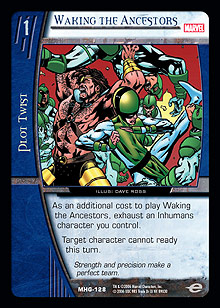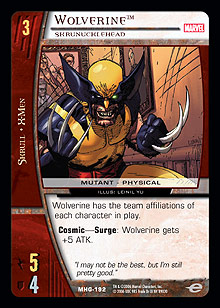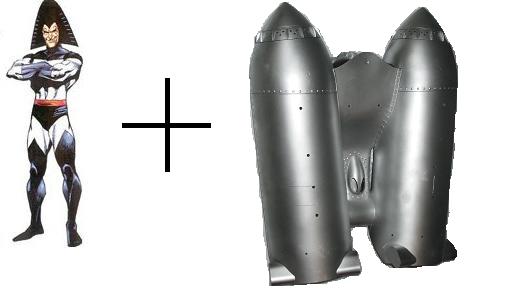Welcome to Part 8 and the conclusion of the Galactus Design Diary with your hosts Andrew Yip and Billy Zonos. This is it—these are our final thoughts, our final accounts, and our final chance to lie and cover up our mistakes.
If I Can Be Serious for a Second . . .
For all intents and purposes, this set was entirely experimental. It was Andrew’s first full lead design, and I had never worked on Vs. before in any capacity. When Andrew first pitched contracting for UDE to me, I was led to believe I would be working mostly on flavor text. Then, he just threw the entire IP design at me. I figured, “I’ve got nothing to lose . . . why not?” Obviously, Andrew had a great deal more to lose. Thankfully, that didn’t stop him from taking some risks—namely, listening to me. To this day I still don’t think Andrew knows how risky that was.
One Year Ago:
Andrew: So now that we know what teams are going to be in the set, what storylines should we base it on? I mean, how do we get all these teams linked?
Billy: Well, anything we do from the comics is gonna be a stretch.
A: Does Doom even interact with the Kree or the Inhumans? Is there any precedent for that?
B: Not really. Can’t we just make one up? Couldn’t we develop a storyline in the set that incorporates all the teams? Nothing overt, just kind of in the background.
A: I don’t know. Is that cool?
B: Let’s find out.
Telling the Story
So that was the agenda from the beginning. Because of the massive massiveness of the Marvel Universe, it was imperative that we limit our scope. We did this by first deciding which teams would make the cut and which storylines would fit thematically with those teams. We covered team selection in the previous articles, but I would still like to point out how wide open that process that was. There are probably ten to fifteen other cosmic-themed teams we could still do in future “space” sets, so if we didn’t include your favorites this time, be patient. We’ll get to them eventually. Narrowing down the teams helped us decide what storylines we could conceivably include.
Anyone that has a working knowledge of comic book history knows that Dr. Doom hasn’t had a great deal of interaction with the Kree or the Inhumans. How many Kree/Galactus crossovers have you read? So, we kind of made some of that stuff up. Well, we didn’t really “make it up” . . . we just sort of pulled some disparate cosmic threads together to form a new tapestry of stars. Since we couldn’t really base the set on any “real” storylines, we tried to imply the relationships in the art descriptions and character selection.
The Art Was Key*
We used two major art themes to tie the teams (Heralds of Galactus, Kree, Inhumans, Doom) together: 1) their relationship to Galactus; and 2) their relationship to the Fantastic Four. I’ve already gone into the whole “Galactus” thing, so we won’t waste any more time on that here. As far as the Fantastic Four goes, we used them as a structuring device—kind of like a “six degrees of super hero separation.” For example, the FF had battled Galactus and Dr. Doom extensively. They had a pretty solid familial relationship with the Inhumans, who in turn were genetically related to the Kree. Although they had not shared any significant storylines, looking at it from this perspective allowed us enough leeway to get away with it. I think. Heck, I don’t know. Whether we succeeded or failed is really up to all of you.
The stuff I just talked about was all well and good, but it still wasn’t enough. It was too subtle. We needed some more obvious connections. This was my first set, so I wasn’t really sure how all this was supposed to work. Looking back at recent Marvel sets, I could see that the main teams from a set never crossed over on character cards. With the exception of cards like Chrome and Trevor Fitzroy, character cards strictly depicted the character in question in some sort of action pose. Team battles or action scenes were reserved for plot twists if they were used at all. Andrew and I decided that this was just not going to cut it for Heralds of Galactus. We needed to get these teams fighting each other—even on their characters’ cards—in order to firmly establish their connections.
 For instance, Dinu; Nahrees; Thing, Rockhead; Final Decree; and Waking the Ancestors illustrate the Inhumans getting it on with Kree soldiers and Doom-Bots. It felt too forced to try to cram Doom or Galactus characters onto Kree cards, so we decided to throw in a supplementary storyline, “Operation: Galactus Storm,” by depicting members of the Avengers and the Shi’ar. Heralds of Galactus was probably the simplest, with cards like The Power Cosmic Unleashed; Frankie Raye ◊ Nova, Harbinger of Death; and Pacification. In direct contrast, Doom was the most awkward fit. The images depicted in cards like Divinity; Technarx; For the Glory of Doom!; and Lancer have, to my knowledge, never happened. But what if? It could conceivably happen. Doom has been known to go cosmic from time to time. And he does like to conquer.
For instance, Dinu; Nahrees; Thing, Rockhead; Final Decree; and Waking the Ancestors illustrate the Inhumans getting it on with Kree soldiers and Doom-Bots. It felt too forced to try to cram Doom or Galactus characters onto Kree cards, so we decided to throw in a supplementary storyline, “Operation: Galactus Storm,” by depicting members of the Avengers and the Shi’ar. Heralds of Galactus was probably the simplest, with cards like The Power Cosmic Unleashed; Frankie Raye ◊ Nova, Harbinger of Death; and Pacification. In direct contrast, Doom was the most awkward fit. The images depicted in cards like Divinity; Technarx; For the Glory of Doom!; and Lancer have, to my knowledge, never happened. But what if? It could conceivably happen. Doom has been known to go cosmic from time to time. And he does like to conquer.
The final piece of the puzzle turned out to be each team’s respective Team-Up card. I tried to embody each team’s main theme in the art descriptions for the Team-Up cards, while Andrew tied them together mechanically. Pressed into Service connects the Kree with the Inhumans and lets you turn those conscripted Inhumans into reservists. For the Glory of Doom! takes conscription to a new level and allows you to KO, kill, and betray your allies. Extended Family refers to the FF/Inhumans family ties and rewards you with a cosmic counter. The Herald Ordeal is probably my favorite; it’s ironic that one of the only times the Heralds actually teamed up was to confront their master, Galactus.
Uniquely Different
As soon as the set was announced, team and character speculation were rampant. It was pretty obvious from the beginning that we had to do the Heralds. It was, after all, the name of the set. Speculators were also pretty adamant about the re-featuring of the Fantastic Four and the Skrulls. A few studious posters even correctly nailed the inevitable inclusion of the Infinity Watch. If we did exactly what was expected, more than half the set would have been spoiled before you saw even a single card! Andrew and I took this into account when we picked the teams and characters.
Why did we really switch out the Skrulls for the Kree? Because you wouldn’t see it coming. Yeah, we have to do the FF. Why not pull a fast one and stick them into the Inhumans? The best fake-out was Doom. No one expected Doom. By all accounts, you were stone-cold sick of Doom.
When the teams were announced at PC: Atlanta, we made sure to muddy the waters enough to keep you all guessing. How many teams did we say were going to be in the set? Six? Seven? I remember how exciting it was reading all the theories online about which teams were going to be main teams and which were destined for 5th-team status. Some of you even made us second-guess ourselves.
I think we met expectations (albeit in an unexpected way) and tossed in a couple of surprising twists to keep it interesting. A Skrull team with barely any real Skrulls that was still actually quite good? Who does that? Vs. System R&D, baby!
The Legacy of Legacy
This is where I tell you about the super-secret legacy idea which trumped the four-card legacy standard. After an exceedingly long conversation, we decided to reduce the legacy content to a minimum of one per team:
B: Can we cut down on legacy? I need more room.
A: Okay.
 And that was the death of the four-card legacy standard. To save even more space, we dual-affiliated a bunch of legacy dudes: Wolverine, Skrunucklehead; Iron Man, Illuminati; Klaw, Sonic Construct; the Kangs; the Fantastic Four; and Magneto, Acts of Vengeance. (Well, he was dual affiliated until Hump got involved. Bad Hump.) Those that couldn’t be dual affiliated were thematically incorporated into the set through their cosmic significance: Mephisto, Lord of Hell; Haywire, Suicidal Lover; Carnage, Symbiote Surfer; and Barnacle. (Yeah, that’s the Avalon Space Station.) Now, there were exceptions; some teams just would not fit into our space set. Of course, we could have done another Genis-Vell or Dark Phoenix, but how lame would that have been? Instead, I had to settle for the “five ugly cards”: Taskmaster; O-Force; Litterbug; Katrina Luisa Van Horne ◊ Amazon; and Mr. Sinister, Supreme Geneticist. The cards themselves weren’t ugly; in fact, a couple of these are downright beautiful. (Litterbug is the ultimate first pick in a draft.) But they just don’t fit. Gah!
And that was the death of the four-card legacy standard. To save even more space, we dual-affiliated a bunch of legacy dudes: Wolverine, Skrunucklehead; Iron Man, Illuminati; Klaw, Sonic Construct; the Kangs; the Fantastic Four; and Magneto, Acts of Vengeance. (Well, he was dual affiliated until Hump got involved. Bad Hump.) Those that couldn’t be dual affiliated were thematically incorporated into the set through their cosmic significance: Mephisto, Lord of Hell; Haywire, Suicidal Lover; Carnage, Symbiote Surfer; and Barnacle. (Yeah, that’s the Avalon Space Station.) Now, there were exceptions; some teams just would not fit into our space set. Of course, we could have done another Genis-Vell or Dark Phoenix, but how lame would that have been? Instead, I had to settle for the “five ugly cards”: Taskmaster; O-Force; Litterbug; Katrina Luisa Van Horne ◊ Amazon; and Mr. Sinister, Supreme Geneticist. The cards themselves weren’t ugly; in fact, a couple of these are downright beautiful. (Litterbug is the ultimate first pick in a draft.) But they just don’t fit. Gah!
Generally Speaking
Generics. They’re supposed to be generic. How much creativity can you get away with here? This is the section of the file where half-formed ideas and unrelated storylines go to die. Ego, The Living Tribunal, and The Watcher were all originally slated to appear as character cards, but we figured out early on that these guys were too powerful for traditional character treatment. The Watcher, for example, was just so ridiculous that he had to be cut from the set!
Then we have the story cards like Armageddon; Assault and Battery; and The Rapture which represented the Infinity Trilogy (Infinity Gauntlet, Infinity War, and Infinity Crusade). We put a couple of the “Secret Wars” characters on the Doom team, so it was only natural to include a Battleworld. The Kyln was a lucky addition because it made us seem like we knew what was going to happen with Marvel’s “Annihilation.”
There were a bunch of other card ideas that just wouldn’t fit. Generic cards were getting cut all the time as we added more and more Skrulls. We still have all the art, so just be patient. Believe me, UDE is not a company that wastes perfectly good art.
The 9th Team
Ah, the surreptitious inclusion of the Illuminati. This was a late, late addition. I don’t think Bendis had even named the group yet when I decided to jam it into the set. I wanted to dual-affiliate the characters because they still lacked a team name (and there was a chance we wouldn’t have one before the file was due), and dual-affiliation also helps express the clandestine nature of their organization. Dr. Strange was within a hair’s breadth of receiving a secondary affiliation himself . . . much like another doctor from the Justice League of America set. Of course, I have to tell you that Professor X’s exclusion from the set was intentional. C’mon, he’s been missing in “Civil War,” right? Why wouldn’t he be missing from Heralds of Galactus?
Carpet Knowledge-Bombing
- Why was Thanos, Alpha and Omega an 8-drop as opposed to a 10-drop? Blame Humpherys ◊ The Enemy of Fun.
- Thanos almost got his own team affiliation with The Fallen One and himself as the sole members.
- Contrary to popular belief, that is not Firelord in the Barbaric Brawl art.
- What else can be said about Barnacle that hasn’t already been said? How about the fact that Andrew Yip was the guy who insisted that he should be included in the set, even after filthy debates resulting in violent fisticuffs? He deserves all the credit.
- The nature of Litterbug’s static pose is directly related to the fact that no one knows what Litterbug actually looks like. I challenge you to find a decent character reference for that Morlock!
- The Plantman on the Katrina Luisa Van Horne ◊ Amazon card is wearing the wrong costume. Not sure how that happened, but I laughed hysterically when I saw it.
- Mephisto, Lord of Hell is wearing a golden energy band around his eyes because I sent in shoddy reference. He’s not supposed to be blind.
- Cannibal Tech is indeed the lost Sentinels legacy card. Yip was unable to crack the design mysteries of the Mega-Sentinel. Believe me, we are better off without his substandard version of that character.
- “I’m hungry, guys. Let’s smash.” That is the unused flavor text for Galactus, Devourer of Worlds. After the decision was made to EA the card, there just wasn’t enough room left.
- “Hey, Billy? We need a reference for a Shi’ar soldier wearing a jetpack.”

And Finally, We Reach the End…
This series probably went four parts too long, but I’m glad you chose to stick with us. Working on Heralds of Galactus was an extraordinary stroke of luck for which I will always be grateful to everyone involved. Right place, right time. I hope they never find out that I probably would have done it all for free. It was an incredible journey, and I’m sure Andrew remembers it as one of the greatest times of his life. We made a ton of mistakes on Heralds, but I promise you we’ve learned from every single one of them. I can’t wait for all of you to see Marvel Team-Up. I’m going to hand it off to Andrew now for the final farewell . . .
Yip’s Final Thoughts
Writer’s block and bad jokes notwithstanding, reflecting on the Heralds of Galactus design has been nearly as fun as designing the set itself; it was certainly more fun than listening to Ben Seck’s latest card mechanics. Speaking of which, once DC Legion of Superheroes releases, the design diaries will be picked up by its lead designer and creative content manager Ben Seck. Now that I’ve fulfilled my weekly quota of beats on TBS, I can safely end my part in this series without regrets. I give thanks to all who have stuck with us this long; 30,000 words is a lot of words on any subject, and we really just scraped the surface. Fortunately, some of those topics will definitely get uncovered over the course of the following months, be they in Ben’s design diary or other R&D articles. As always, any feedback you guys have is welcome. Until Marvel Team-Up!
*Well, not quite. I’m pretty sure the actual design of the cards is infinitely more “key.”**
**It is a well-publicized fact that Andrew hates the physical act of writing.***
***Hence the reason you get this all filtered through the lowly “IP Guy.”